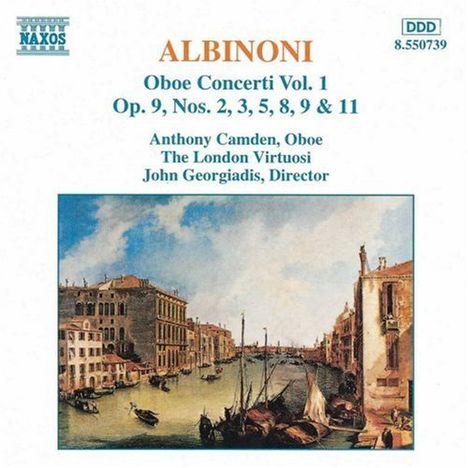Tomaso Albinoni: Oboenkonzerte op.9 Nr.2,3,5,8,9,11 auf CD
Oboenkonzerte op.9 Nr.2,3,5,8,9,11
Herkömmliche CD, die mit allen CD-Playern und Computerlaufwerken, aber auch mit den meisten SACD- oder Multiplayern abspielbar ist.
(soweit verfügbar beim Lieferanten)
- Künstler:
- Anthony Camden, Julia Girdwood, The London Virtuosi, John Georgiadis
- Label:
- Naxos
- Aufnahmejahr ca.:
- 1992
- Artikelnummer:
- 3084965
- UPC/EAN:
- 0730099573924
- Erscheinungstermin:
- 29.3.1993
Die Konzerte op. 9 sind in vier Gruppen unterteilt, die jeweils mit einem Konzert für Solovioline (hier ist die Oboe nicht aktiv) beginnen, mit einem Konzert für eine Oboe fortgesetzt werden und mit einem Konzert für zwei Oboen enden. Nr. 5, in C-Dur, ist ein typisches Beispiel für den Spätstil des Komponisten. Die orchestrale Textur ist stellenweise sehr kontrapunktisch, aber Albinoni opfert die Melodie niemals einer Show des Lernens. Arthur Hutchings, sein größter Fürsprecher unter den britischen Musikwissenschaftlern, beschreibt das Finale treffend als "den Reiz des Tanzes vermitteln, ohne die Straße oder den Bauernhof anzudeuten".
F-Dur ist eine der traditionellen Tonarten des Naturhorns, das wegen seiner Assoziation mit der Jagd als Emblem des Adels und der höfischen Lebensweise behandelt wurde. Dementsprechend füllt Albinoni als Hommage an den bayerischen Kurfürsten die schnellen Außensätze des dritten Konzerts mit Jagdrufen. Das Meisterwerk des Satzes ist zweifellos das zweite Konzert, dessen langer, elegischer langsamer Satz als Albinonis zweites Adagio" bezeichnet wird.
Die Konzerte in B-Dur (Nr. 11) und g-Moll (Nr. 8) vervollständigen die Gruppe der Konzerte mit einer Oboe. Albinoni war sehr sensibel für die Assoziationen verschiedener Tonarten. Für ihn ist B-Dur hell und durchsetzungsfähig, g-Moll melancholisch und introspektiv. In ähnlicher Weise entspricht auch die Tonart des anderen "Doppelkonzerts" in dieser Aufnahme, Nr. 9 in C-Dur, einem vertrauten Stereotyp und triumphiert mit einem Hauch von Aufgeblasenheit. Glücklicherweise bieten die langsamen Sätze, die in jedem Fall in einer anderen Tonart stehen, den nötigen Kontrast und verleihen jedem Werk einen abgerundeten Charakter.
Product Information
The Op. 9 concerti are subdivided into four groups, each of which begins with a concerto for solo violin (here the oboe is silent), continues with a concerto for one oboe and finishes with one for two oboes. No. 5, in C major, is a typical specimen of the composer's late style. The orchestral texture is in places highly contrapuntal, but Albinoni never sacrifices tunefulness to a show of learning. Arthur Hutchings, his greatest advocate among British musicologists, aptly describes the finale as 'conveying the allure of the dance without suggesting the street or barnyard'.
F major is one of the traditional keys of the natural horn, which because of its association with hunting was treated as an emblem of the nobility and the courtly way of life. Accordingly, Albinoni, in homage to the Bavarian elector, fills the fast outer movements of the third concerto with hunting calls. The masterpiece of the set is undoubtedly the second concerto, whose long, elegiac slow movement has been dubbed Albinoni's second Adagio'.
The concerti in B flat major (no. 11) and G minor (no. 8) complete the group of concerti with one oboe. Albinoni was very sensitive to the associations of different keys. For him, B flat major is bright and assertive, G minor melancholy and introspective. Similarly, the key of the other ‘double’ concerto in this recording, no. 9 in C major, conforms to a familiar stereotype, being triumphant with a touch of pomposity. Luckily, the slow movements, which in every case are in a different key, provide the necessary contrast and give each work a well-rounded character.
Disk 1 von 1 (CD)
Konzert für Oboe, Streicher und Basso continuo C-Dur op. 9 Nr. 5
-
1 1. Allegro
-
2 2. Adagio (non troppo)
-
3 3. Allegro
Konzert für 2 Oboen, Streicher und Basso continuo F-Dur op. 9 Nr. 3
-
4 1. Allegro
-
5 2. Adagio (non troppo)
-
6 3. Allegro
Konzert für Oboe, Streicher und Basso continuo d-moll op. 9 Nr. 2
-
7 1. Allegro e non presto
-
8 2. Adagio
-
9 3. Allegro
Konzert für Oboe, Streicher und Basso continuo B-Dur op. 9 Nr. 11
-
10 1. Allegro
-
11 2. Adagio
-
12 3. Allegro
Konzert für Oboe, Streicher und Basso continuo g-moll op. 9 Nr. 8
-
13 1. Allegro
-
14 2. Adagio
-
15 3. Allegro
Konzert für 2 Oboen, Streicher und Basso continuo C-Dur op. 9 Nr. 9
-
16 1. Allegro
-
17 2. Adagio (non troppo)
-
18 3. Allegro
Mehr von Tomaso Albinoni




